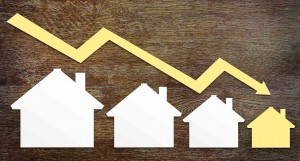Clearly 2019 will be a challenging year for property and the Australian economy. 
There has been a lot of speculation about the effect of falling Australian house prices on the broader economy.
Some commentators are suggesting that the negative wealth effect of weaker house prices and falling consumer confidence at present with so much happening in the political and economic environment could combine into a negative feedback loop.
Others suggest the continual conveyer belt of negative media could become a self fulfilling prophecy.
Yet others are using the dreaded “R” word (recession)
However ANZ Bank Chief Economist Richard Yetsenga believes this is unlikely outcome.
In a recent research paper for the Bank’s professional and private clients Yetsnega gives his views.
These were also published in part by the Australian Financial Review.
Yesenga explains that…
Typically when house prices are falling there is plenty going wrong elsewhere.
Prior to the current episode, house prices fell in 1982, 1990, 1995, 2004 (very briefly), 2008 and 2011.
All except 2004 were associated with either an Australian recession, near-recession or significant global slowdown.
While global growth has slowed over the past year it remains above trend and strong enough to have reduced unemployment in virtually every advanced economy.
The Australian economy has also slowed but most indicators suggest it is running strongly enough to drive the unemployment rate down further.
This housing downturn was sparked largely by a tightening in prudential policy, which has a narrow and direct impact.
It was not driven by monetary policy, where the impact is broad.
On this occasion both monetary and fiscal policy are in fact adding to demand, whereas historically policy has tended to be tightening when house prices have started to fall.
Interest rates are very low and the exchange rate is providing stimulus.
The AUD in trade-weighted terms is the weakest since coming out of the financial crisis in 2009.
In addition, all previous periods of declining house prices, with the exception of in 2004, were associated with significant slowdowns in public demand.
Yet since 2015 demand has been growing at between 4% and 6%.
With the federal budget on the verge of returning to surplus, spending could strengthen even further.
 Direct bottom-up support for the housing market is not difficult to envisage.
Direct bottom-up support for the housing market is not difficult to envisage.
Indeed, because balance-sheet-driven downturns in the economy are so potentially damaging and typically long lasting, further extended house price declines are likely to increasingly justify policy action.
We are already seeing some movement.
In December APRA removed the interest-only lending restrictions introduced in March 2017.
But more broadly, as bottom-up prudential standards tighten, some of the standards that essentially provided top-down insurance on the lending process could be loosened.
There is precedent for this.
Earlier in 2018 APRA removed the benchmark on investor lending, subject to banks meeting more stringent bottom-up lending standards.
Another example might be the mortgage interest-rate buffer introduced in 2014 which mandates an interest-rate floor of ‘at least’ 7% compared with current variable mortgage rates at 5%.
 The floor seems to have been based on the idea we are in a historically anomalous ‘low-interest-rate environment’.
The floor seems to have been based on the idea we are in a historically anomalous ‘low-interest-rate environment’.
However as time passes historical precedent seems less and less relevant, as has been the case in many other economies post-crisis.
A 200bp increase in interest rates seems untenable in the current cycle, let alone anything materially larger.
The irony is by continuing to impose such a strong top-down prudential standard at the same time as bottom-up standards are tightened, APRA is making any meaningful increase in interest rates much less likely.
There are some winners from house-prices decline – first-home buyers an obvious one.
That activity has picked up sharply since 2017 and now makes up nearly a fifth of finance approvals.
There are also plenty of home owners who don’t watch every ripple in the housing market.
A third of households have no mortgage and a third of those with mortgages are more than two years ahead of their payments.
For them, jobs and wages are much stronger drivers of their behaviour.
On this basis there appears to have been little forced selling, at least in a macro sense.
While much has been made of the increased number of properties for sale, this reflects the slow pace of sales for existing stock rather than a rush of new stock coming to market.
CoreLogic data shows new property listings were down over the past year in both Sydney (-10.9%) and Melbourne (-17.3%).
Provided prudential standards are correctly calibrated for the tightening in bottom-up standards, forced sellers in the housing market shouldn’t be sufficient to turn what really has been a textbook adjustment so far, into something much worse.
Source: ANZ Blue Lens. This was prepared for their commercial and professional clients for the purpose of providing general information, without taking account of any particular investor’s objectives, financial situation or needs. They advise that an investor should, before making any investment decisions, consider the appropriateness of the information in this article, and seek professional advice, having regard to the investor’s objectives, financial situation and needs.
A version of this article was also published in The Australian Financial Review, 23 January 2019


No comments:
Post a Comment